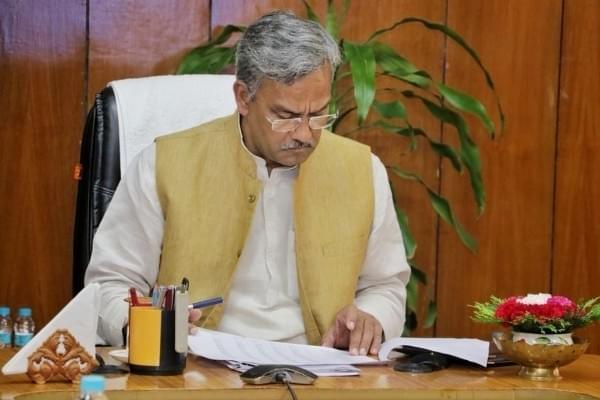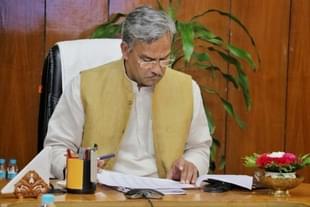News Brief
Not The First Time: Uttarakhand Returns As The Venue For Communist Nepal’s Territorial Assertion
Swarajya Staff
May 27, 2020, 07:29 PM | Updated 07:27 PM IST
Save & read from anywhere!
Bookmark stories for easy access on any device or the Swarajya app.


The rising tensions between Nepal and India have put Uttarakhand in focus once again.
The state has three districts bordering Nepal -- Pithoragarh, Champawat and Udham Singh Nagar. Out of these, Pithoragarh has been in the news recently.
Last week, Nepal PM KP Sharma Oli asserted that Lipulekh, Kalapani and Limpiyadhura belong to Nepal and said that Nepal will "reclaim" them from India through political and diplomatic efforts.
Oli said that his cabinet has endorsed a map that shows the three areas as territory of Nepal. He added that India has made it into a disputed area by keeping the issue "disputable".
This report indicates that however that Oli is unable to "build consensus around the new map among Nepal parties", as many feel that he could be invoking sentiments in Nepal for personal gains.
Nepal's other neighbour, communist ruled-China's own aggression towards India has co-incidentally landed in the same time slab.
Uttarakhand chief minister Trivendra Singh Rawat, after certain developments took place towards the end of 2019, had said that the core essence of Nepal and Nepali culture has been infiltrated by certain elements, and the kind of narrative that has arisen out of there is against that very culture.
He said that parts of India will remain India's and the narrative that is arising out Nepal can be solved over a dialogue and talks with the friend nation.
The issue has been a matter of concern for Uttarakhand.
This year, the issue gathered heat after Union Defence Minister Rajnath Singh inaugurated the crucial road link from Dharchula in Pithoragarh district to Lipulekh on the China border.
Delighted to inaugurate the Link Road to Mansarovar Yatra today. The BRO achieved road connectivity from Dharchula to Lipulekh (China Border) known as Kailash-Mansarovar Yatra Route. Â Also flagged off a convoy of vehicles from Pithoragarh to Gunji through video conferencing. pic.twitter.com/S8yNeansJW
— Rajnath Singh (@rajnathsingh) May 8, 2020
The development also connects to better border connectivity and makes the travel to Kailash-Mansarovar pilgrimage shorter as compared to the other routes through Sikkim and Nepal, and a considerable part of the journey will be on Indian roads.
The road (80 km long) originates from Ghatiabagarh and terminates at Lipulekh Pass which is the gateway to Kailash-Mansarovar. It is also expected to spur economic activity in the region.
Singh flagged off a convoy of vehicles to Gunji (in Pithoragarh district) via video conferencing.
This event was attended by Chief of Defence Staff General Bipin Rawat, Chief of Army Staff General M M Naravane, Defence Secretary Dr Ajay Kumar.
Ajay Tamta -- Lok Sabha MP from Almora (Uttarakhand) was also present at the occasion.
People in the region of both sides of the border share a common sentiment and culture. Social harmony between the residents of the region has been part of their cultural character.
This became evident when earlier this month, supporters of the Netrachand Viplav Party, who came for flag hoisting in Lipulekh faced protests from Nepalese residents.
This report says that when the group reached Dumling village, people asked them to return. People of the village value the relations with the residents in India. Such an act could be seen as counter productive to the harmonious ties and the developmental progress that is expected in the region.
Nepal is now planning to instal 114 armed border outposts along the entire length of its border with India, out of which 10 would be set up on its border length shared with Uttarakhand. Out of these 10, six could be in the area around Pithoragarh district -- which has the proximity to Lipulekh Pass.
Champawat and Udham Singh Nagar, the other two districts that border Nepal, will also see the setting of outposts by Nepal on its side. One such border outpost has begun to function in Chhangru village near the Lipulekh Pass. The pass is known as the gateway to Tibet.
The Ministry of External Affairs has said that the road lies "well within the Indian territory."
Tensions between India and Nepal have brought Uttarakhand into focus in the past as well. This report from January 2008 says: “The Nepal border at Uttarakhand became tense on Friday after Maoists crossed over to the Indian side and damaged property. The Maoists of the Young Communist League had tried unfurling red flags on the no man’s land between India and Nepal on December 25, but were stopped. Although security was believed to have been stepped up at the porous border after the incident, they still crossed over near Tanakpur in Champawat district on Friday”.
Then chief minister of Uttarakhand, BC Khanduri (BJP government) had termed the threat from Nepal's Maoists a serious one. The report says: "...he said the recent incidents could be an attempt by parties like the Communist Party of Nepal (Maoist) to grab attention ahead of polls in that country."
With the assertion in the narrative from Nepal's communist regime mentioning "inches" of Kalapani, Uttarakhand has found itself at another patch of territorial aggression from the neighbouring country. The Nepali sentiment is part of its own culture, emotion and socio-economic contours. This sentiment is reciprocated by the culture-inclined and friendly residents on the Nepalese side.





